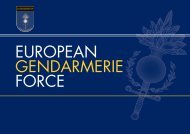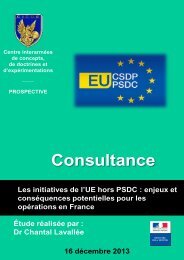Conference
science-research-bulletin-2013-conference
science-research-bulletin-2013-conference
You also want an ePaper? Increase the reach of your titles
YUMPU automatically turns print PDFs into web optimized ePapers that Google loves.
EUROPEAN POLICE SCIENCE AND RESEARCH BULLETIN<br />
SPECIAL CONFERENCE EDITION<br />
found that investigators tended to be ‘overcautious’<br />
in their dealing with the police in<br />
order to avoid giving offence (Savage, 2013a).<br />
So, for example, they were reluctant to seize<br />
officers’ notebooks. Similarly, in criminal cases,<br />
police suspects are rarely arrested, detained and<br />
interrogated under caution in custody. The first<br />
arrest by the GSOC did not occur until December<br />
2012, more than five years after it commenced<br />
operations. Typically, an investigator will simply<br />
take a statement by appointment from the officer<br />
or officers and check it against the complainant’s<br />
statement and other independent evidence.<br />
Inconsistencies are not normally pursued through<br />
robust questioning. Documentary or material<br />
evidence supplied by the police is usually accepted<br />
at face value, even to the extent that investigators<br />
do not check independently if that is the sum total<br />
of evidence available. Savage also found evidence<br />
of ‘independent’ investigators ‘going native’,<br />
as reflected in their tendency to adopt police<br />
terminology and mindsets (Savage, 2013b).<br />
The regulatory capture is institutionalised through<br />
the contents of Protocols agreed between the<br />
independent Commissions and the police. Typically,<br />
they will regulate matters such as how and the<br />
extent to which Commission investigators can get<br />
access to police records, information, intelligence<br />
and stations. They will also address arrangements<br />
for interviewing police officers. In theory they are<br />
aimed at facilitating smooth cooperation between<br />
the police and the Commissions in investigations.<br />
In practice, they tend to blunt the independent<br />
powers of the Commissions and cede excessive<br />
control over investigations to the police (Savage,<br />
2013a); sometimes to the detriment of effective<br />
investigation.<br />
Instead of enhancing the smoothness and efficacy<br />
of investigations, the Protocols agreed between<br />
the Commissions and the police can actually prove<br />
counterproductive. The GSOC, for example, has<br />
voiced concerns about the capacity of the Protocols<br />
to blunt the independence of its oversight role. In<br />
a 2013 report on an investigation into the police<br />
handling of an informant, it complained candidly<br />
that ‘.. under the present Protocols, [it] is wholly<br />
reliant upon assurances from the [police] that<br />
the evidence and information they have supplied<br />
represents the totality of such information held.<br />
This leaves scope to question the completeness<br />
and independence of oversight.’ (GSOC, 2013a<br />
para. 10.2).<br />
POLICE OBSTRUCTIONISM<br />
Police obstructionism is also proving an enduring<br />
obstacle to the capacity of the independent<br />
Commissions to deliver effective investigations.<br />
Once again there is a link with the Protocols. In<br />
2013, for example, the GSOC took the highly<br />
unusual step of going public in its criticisms of<br />
police delay in supplying relevant information<br />
concerning their policing of a student protest<br />
that had generated multiple complaints (GSOC,<br />
2013b). Instead of exercising its own powers to<br />
seize the information directly, the Commission<br />
complied with the Protocols and requested its<br />
production from the police. The Protocols specify<br />
a time limit of 30 days for compliance. In the<br />
event it took 224 days and numerous requests<br />
before the police supplied any documents, and<br />
634 days for the Commission to get a copy of the<br />
parallel police investigation file on the protest.<br />
In some situations the police actually supply false<br />
or misleading information. In the student protest<br />
investigation, for example, the police claimed<br />
falsely that there were no statements from<br />
officers who used batons on the day (GSOC,<br />
2013b). Similarly, police management attempted<br />
to conceal the availability of video evidence taken<br />
by police officers (GSOC, 2013b).<br />
SHORTAGE OF RESOURCES<br />
Underlying some of these problems is a shortage<br />
of resources available to the independent<br />
Commissions. The UK parliamentary committee,<br />
for example, pointed out that the resources<br />
available to the independent Commission for<br />
investigations are dwarfed by the comparable<br />
resources available to the police (HAC, 2013,<br />
para.33). Inevitably, this leaves the Commissions<br />
excessively dependant on the police to advance<br />
their investigations, and even to carry out<br />
the investigations. The Commission itself told<br />
the inquiry that it does not currently have<br />
sufficient resources to enable it to meet its<br />
statutory responsibility or the public’s growing<br />
expectations of its role (HAC, 2013, para.30).<br />
55





